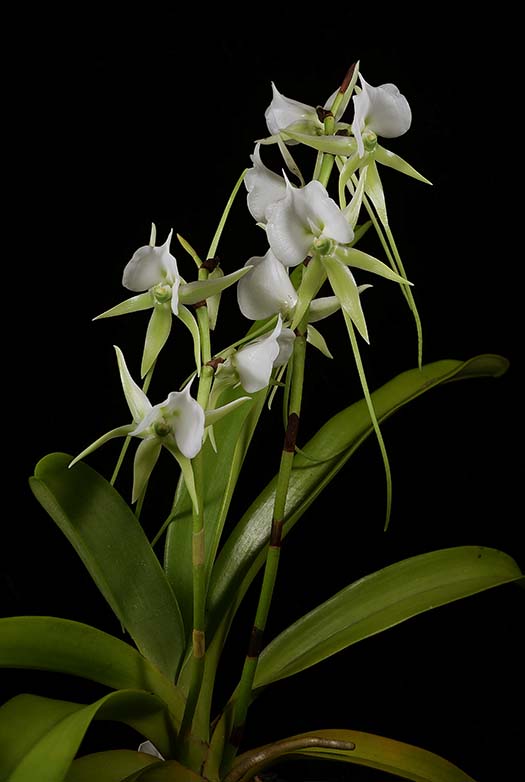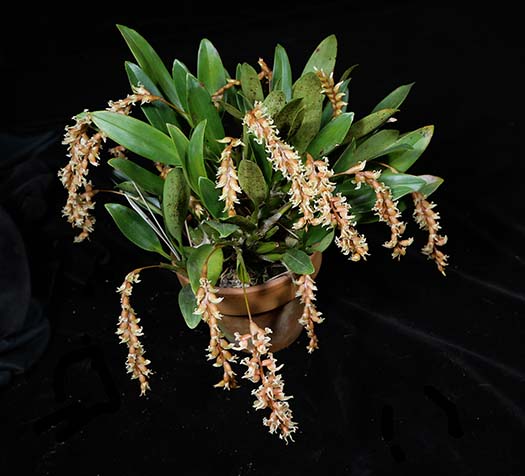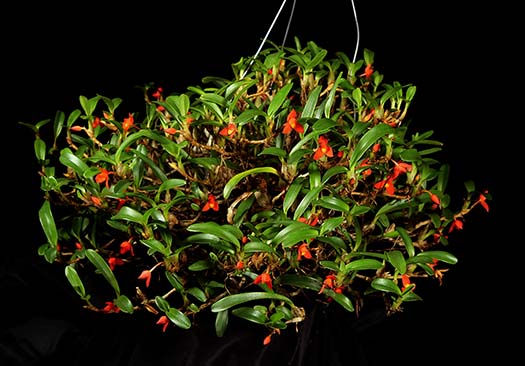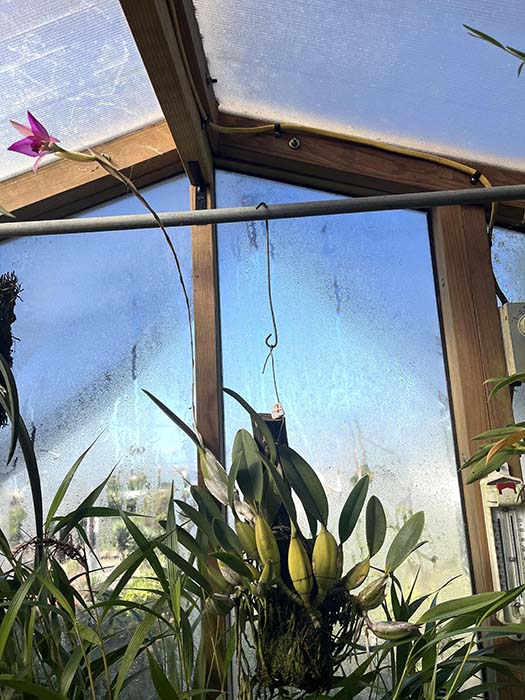December 2024
From Scott McGregor:All orchids grown outdoors, coastal southern California |
|
Bulbophyllum pardolatumA mat-forming mini from the Philippines, I grow it mounted and bright. The long-lasting flowers are only open for a few hours each sunny morning and are closed after noon until the next sunny morning. |
 |
 |
Eulophia speciosaOpening the final half-dozen of 77 total flowers on a 5’ long spike, this plant has been in continuous bloom with sequentially opening flowers from June through November. It is potted in sand and seems to enjoy south-facing full sun. |

Isochilus sp "OZ" (Colombia),
|
|
From Roberta Fox:Coastal southern California |
|
Outside in the Back Yard: |
|
 strupifolia t.jpg) |
|

Angraecum longicalcarNative to the central highlands of Madagascar, elevation 1000-1200 m. It grows in exposed areas, in almost full sun. I grow it in direct morning sun, filtered later in the day. |
 |

Cattleya labiata f. coeruleaI have found that this Brazilian native grows well outside, better than it did in the greenhouse. Habitat elevation is 500-1000 m, but clearly it can tolerate winter chill. |

Cattleya percivaliana 'Mendenhall Summit x self'It must be near holiday time! Of my three cultivars, this is the first to bloom this year. Of the three, it has the smallest flowers (only about 5 inches) but great color. 'Orchid Ranch', with 7 inch flowers will bloom in another month or so. The flowers last 4-6 weeks on all of them. It's native to Colombia and Venezuela, elevation 1400-2000 m. It is one of the most cold-tolerant of the big Catts. |

Dendrochilum cootesiiThe individual flowers with their curly setments and the twisted inflorescences are fascinating. The plant is only about 6 inches tall, with similar width, but it gets more floriforous every year. Native to the Philippines, at elevations from 1200-2000 m. |
 |
 |
|

Dendrobium (Diplocaulobium) aratriferumThis plant produces a few flowers on and off all year, but about twice a year I get a flush bloom. Flowers have the fragrance of watermelon. Flowers are ephemeral, lasting about a half day. The buds emerge a day or two before so there's a bit of warning, but don't blink or you'll miss it. Native to New Guinea. No elevation data provided, IOSPE says "hot to warm" but it tolerates winter cold on my patio so clearly it grows over a range of elevations. |
 |
 |
|

Epidendrum quisaynumFlowers are about 1/2 inch. It produces flowers over about two months. Native to Ecuador, 1300 - 3300 m. |
 |
 |
 |
Pelatantheria insectiferaMyanmar and northeast India, elevation sea level to 850 m. This Vandaceous species has clusters of half-inch flowers from nodes all over the plant which branches, and rambles all over the mount and sends roots and growths out into the air as well. |
|

Scaphosepalum sp.I showed this about 6 months ago, and I still don't know anything about it, except that it is tiny, flowers only about 2-3 cm. (It was mis-labeled by the vendor's supplier, the vendor hasn't been able to identify it, not for lack of trying.) The plant is in a 2-inch basket. It is producing more inflorescences, each one of which produces blooms sequentially. It is pretty much always in bloom, one just has to look closely. It has taught me a lot about photographing small flowers. |
 |
 |
|

Sobralia sp.Labeled Sob. macra but it isn't. Scott showed this one last month. What makes it distinct is that it has two types of inflorescence. There is the typical one, at the tip of the vertical growth above the leaves (above right) but also blooms on leafless or nearly leafless pendant growths at the base of the plant (above left). At the lower right is a photo of the flower. |
 |
 |
|

Trisetella hoeijeriBird-like flowers float about 2 inches away from the plant, on hairlike inflorescences. Leaves are about 1/2 inch, the flowers almost 2 inches from tip to tip. Native to Ecuador, from cloud forest at around 1800 m. I keep it as moist as I can, it likely would do even better with higher humidity. |
 |

Trisetella triglochinI saw this species along the Rio Negro in Brazil, in the Amazon region at sea level. It also grows at elevations up to 2200 m, over a wide area of northern South America and into Central America as far north as Costa Rica. With this wide range of elevations and territory, it clearly can grow anyplace that provides some humidity. Cold, hot, it doesn't care.
|
 |
 |
Cattleya (Laelia) pumila
|

Maxillaria ubatubanaA flower machine from southeastern Brazil. Each flower may not be big and grand, but the mass of them is impressive. The plant is vigorous, and it blooms like this reliably, every year. |
 |

Holcoglossum kimballianumNative to a wide area including south-central China and souteast Asia, elevation 1220-1520 m. It can grow either as an epiphyte or lithophyte, sometimes in full sun. I grow it in a basket with little medium, and it produces long, free-ranging roots. |
 |

Maxillaria sophronitisFrom northern Venezuela and into Colombia, elevation 760-1520 m. It produces flowers on and off all year around, with flush blooms 2-3 times a year. It blooms reliably around the December holidays, with an appropriate color scheme. Flowers are only about 1/2 inch, but the mass of them, contrasted with the dark green leaves, put on a good show. Flowers are somewhat crystalline, and glow brilliantly in the sunshine. |
|
In the greenhouse... |
|

Angraecum distichumNative to low elevations in tropical west and central Africa. It blooms frequently, a few times a year produces a flush bloom. Leaves are succulent. |
 |

Cattleya maxima f. concolorNative to Ecuador, Peru, and Colombia. This is the lowland form, needing warmth. There is also a highland form that tolerates cold. Most of the non-typical color forms are found in the lowland variety. |
 |

Dendrobium smilliaeNative to northern Australia and Papup New Guniea, elevation up to about 600 m. It can bloom repeatedly on bare canes over several years. The dark green lip contrasts dramatically with the white and pink flowers. |
 |
 |
|

Laelia aureaNative to Mexice NW, NE, SW, elevation 100-300 m. (Those from Mexico are still Laelia...). It is closely related to L. rubescens which comes from higher elevations. Those will likely bloom next month outdoors. Flowers are rather short-lived, around a week. |
 |

Maxillaria scalariformisThis species typically blooms twice a year. It lives outside in spring, summer and early fall, when nights are above about 50 deg. F. and the spring/summer blooming was shown with the outdoor plants. But nights have been quite chilly so it has moved into the greenhouse. Andy Phillips manages to grow these outdoors all year, but I have killed several that way although my climate is very similar to that in Encinitas, CA. Winter in the GH works better for me. These like to stay very wet, potted in sphagnum. Native to Panama. elevations 1000-1300 m. |
 |
 |
 |
Zootrophion alvaroiNative to Colombia and Ecuador, elevation 400-600 m. The flowers remind me of little baloons. This is as open as they get. The pollinator is certainly very tiny, to get in that little slit. It produces a flush bloom several times a year. |
|
From Chris Ehrler:
|
|
California Central CoastCool greenhouse unless otherwise noted. |
|

Dendrochilum cobbianumA cool growing species from the Philippines at elevations above 1200 meters. Grows either epiphytically or as a lithophyte. Growing in a plastic container that is filled with hydroponic type clay balls. There is a hole drilled in the plastic so that there is no more than 1 inch or so of water in the bottom of the container. |
 |
Masdevallia veitchianaGrows around Machu Picchu on steep rocky slopes covered with grasses and shrubs in full sun but with the leaves protected by the grass occurring at elevations of 2000 to 4000 meters as a small sized, cold growing terrestrial, sometimes lithophytic or rarely epiphytic. This orchid is growing in a plastic pot filled with a bark and lava rock mixture. The purple color on the sepals is due to the presence of minute purple hairs. |
|

Myoxanthus punctatusGrows in southern Brazil at elevations around 670 to 1500 meters as a warm to cool growing epiphyte. This orchid is growing on a piece of cork oak.. Plant was acquired in the latest FCOS auction and was donated by the Huntington Orchid Collection. |
 |

Myoxanthus serripetalus 'Chris' AM/AOSA cool to cold growing terrestrial or epiphyte found in Peru and Ecuador on the eastern Andes at elevations of 1,000 to 3,100 meters. This plant is about 3 feet tall and produces flowers throughout the year. This orchid is growing in a clay pot filled with moss in a cool greenhouse. But some keikeis from this orchid are growing well outside in a clay pot filled with moss. |
Pleurothallis alleniiGrows in central Panama as a warm to cool epiphyte at elevations between 550 and 1,000 meters. This plant grows mounted on a piece of wood with a small amount of sphagnum moss on the roots. |
Pleurothallis grobyi typeA cold to hot growing species from 60 to 3200 meters in Mexico, Belize, Guatemala, El Salvador, Nicaragua, Costa Rica, Venezuela, Colombia, Ecuador, Peru, Brazil, French Guiana, Surinam, and Guyana. |
|
 side cropped.jpg)
Restrepia chameleon (pale form) |
 front cropped.jpg) |
Restrepia chameleon (typical form)A cold growing epiphytic species found at about 2,700 meters of elevation in Colombia. |
|
Restrepia gutullata (yellow form)A cold to cool growing epiphyte found in Colombia, Ecuador, Peru, and Venezuela at elevations of 1,700 to 3,000 meters. |
|

Restrepia landsbergiiFound at elevations of 700 to 3,000 meters in Venezuela, Ecuador, and Peru growing as a cool to cold growing epiphyte. |
 |
Resetrepia musciferaA warm to cool growing species found in rainforests in Mexico, Belize, Guatemala, Honduras, El Salvador, Nicaragua, Costa Rica, Panama, Colombia, and Ecuador at elevations of 300 to 2,500 meters. |
|
Scaphosepalum decorumA cool growing epiphyte native to southern Colombia where it grows in cloud forests at elevations around 1800 meters. Grows in a pot with a bark and lava rock mixture. |
|
 |
|
Specklinia (Pleurothalis) montezumaeA warm growing epiphyte found at an elevation of 600 meters in Costa Rica. Currently growing well in a cool greenhouse. |
|

Vanda nanaA warm to cool growing species growing in Thailand, Vietnam, and Cambodia. |
 |
From Arnold Markman:
|
|
Coastal San Diego area
|
|
 |
 |
Bulbophyllum lasiochilumThis orchid grows in seasonally dry low land forest in Thailand. Some references list it as "hot to warm" but others indicate that it can go down to 50 deg. F. (Ed. note: it can go a lot colder than that, 40 deg. or so) I don't dry it out ever, and it is doing fine. Greenhouse went down to 50 deg. F. |
|
 |
 |
Prosthechea (Encyclia) garcianaThis orchid grows in Venezuela cloud forest at 1300 m. |
|
 |
 |
Epidendrum porpaxThis orchid grows in Mexico in cloud forests up to 1800 m. |
|
 |
 |
Epigeneium chapaenseThis small, mat -forming Orchid is from Vietnam. (Ed. note: Kew, Dendrobium tsangianum, previously Den. brunneum) |
|
 |
 |
Eria coronariaThis orchid grows in the eastern Himalayas and is found in semi deciduous forests at elevations of up to 2300 m. It seems to like a lot of water since it does not have pseudobulbs, but only a rhizome to store water. |
|
 1.jpg) |
 2.jpg) |
Gastrochilus somae (japonicus)This plant is listed in IOSPE as G. japonicus. It grows as high as 2000m as an epiphyte in montane forests in Taiwan. I had recurrent scale problems which led to the brown spots on the leaves but I think the scale is gone and it has finally flowered. (Ed Note: Kew lists them as separate species but previously, G. somae was considered synonym for G. japonicus, likely this is G. japonicus, G. somae has a very small range.) |
|
 |
 |
Laelia anceps var. guerreroI’ve had this Mexican orchid that grows at altitude for 4 1/2 years and am excited to see it finally bloom. I grow it in the sunniest western edge of the greenhouse. |
|

Maxillaria scalariformisThis plant is from Costa Rica and Panama and I keep it wet at all times. It grows in rainforest at elevations up to 1300 meters. |
 |
 |
 |
Aerides quinquevulnera- This plant comes from both Malaysia and the Philippines as high as 2000 m. According to one reference, the genus means “children of the air“, and in the Philippines was referred to as “flower of the sacred sleep.“ |
|
 strupifolia 3.jpg)